I think you will really enjoy this recipe for flaky cheese biscuits. With Old Bay seasoning in the dough and loads of shredded cheddar rolled and folded in for delightfully layered biscuits, these guys are great on their own or for making little sandwiches.
I’ll show you how to make flaky biscuits that rise high, and I’ll also give you tips to get them to rise Super High. I made similar biscuits by the tens of dozens daily at the restaurant, so I will walk you through all the steps.
If you love cheddar cheese as much as I do, you may also like my mom’s cheese olive puffs. You may also like my angel biscuit recipe which has tons of layers in them too.
For ease of browsing, you can find all my bread and rolls recipes in one place. Thanks for being here!
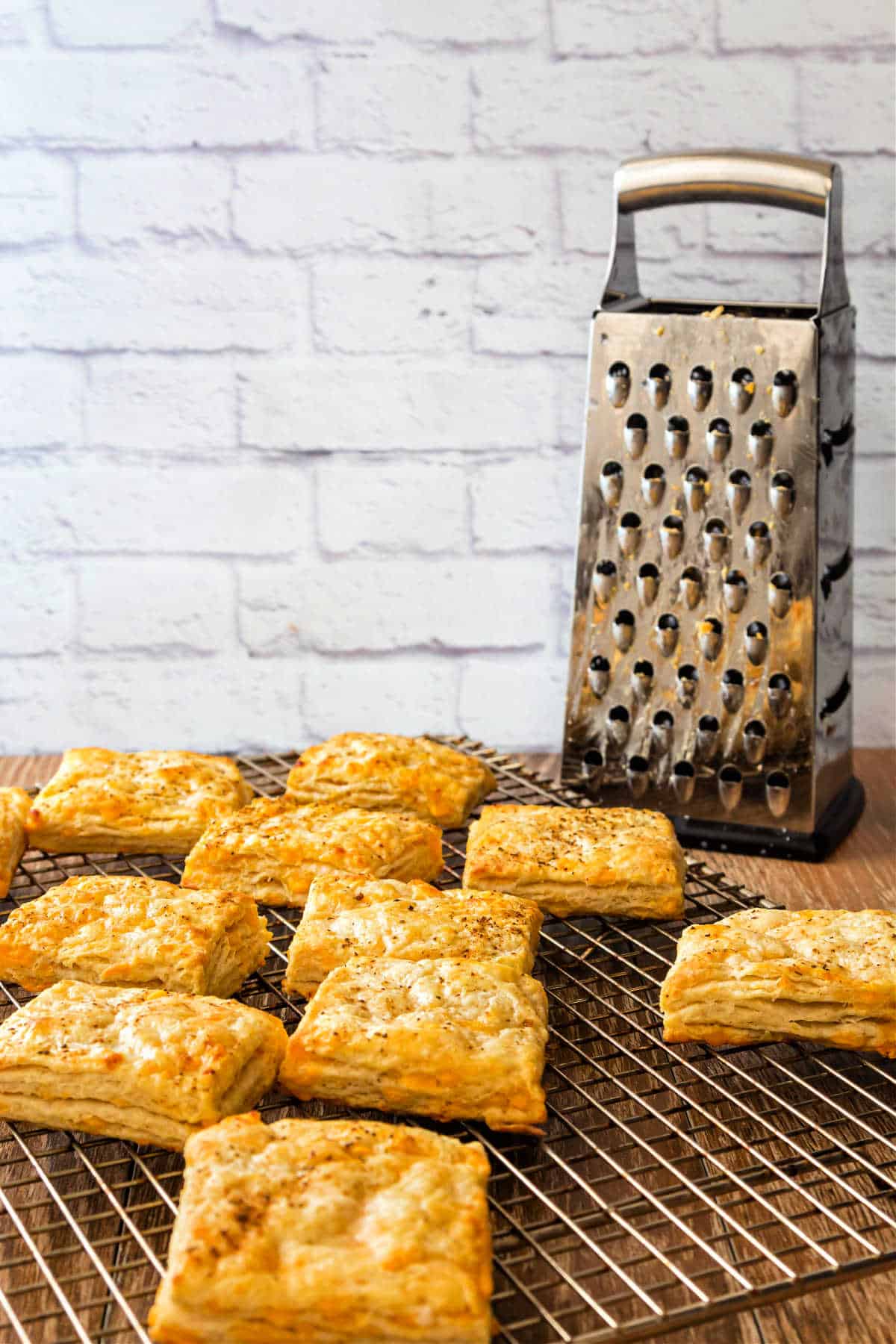
What’s So Great About These Cheese Biscuits
These guys are Chock Full of sharp cheddar cheese.
They’re seasoned with Old Bay, so as far as I’m concerned they’re kinda like cheddar bay biscuits.
Most folks say there is no Old Bay in cheddar bay biscuits, but I say there should be, so I use it.
Pastry Chef Online Participates in Affiliate Programs. If you make a purchase through one of my links, I may earn a small commission. For more information click to read my disclosure policy
If you have Old Bay, do put it to use here!
While “real” Red Lobster copycats are drop biscuits, these guys are flaky and layered. This makes them a bit more sturdy (to offset all the cheese and hold them together) so you can use them as the base for little sandwiches.
And if you don’t want to make sandwiches, know that you can eat these without the biscuits disintegrating and crumbling.
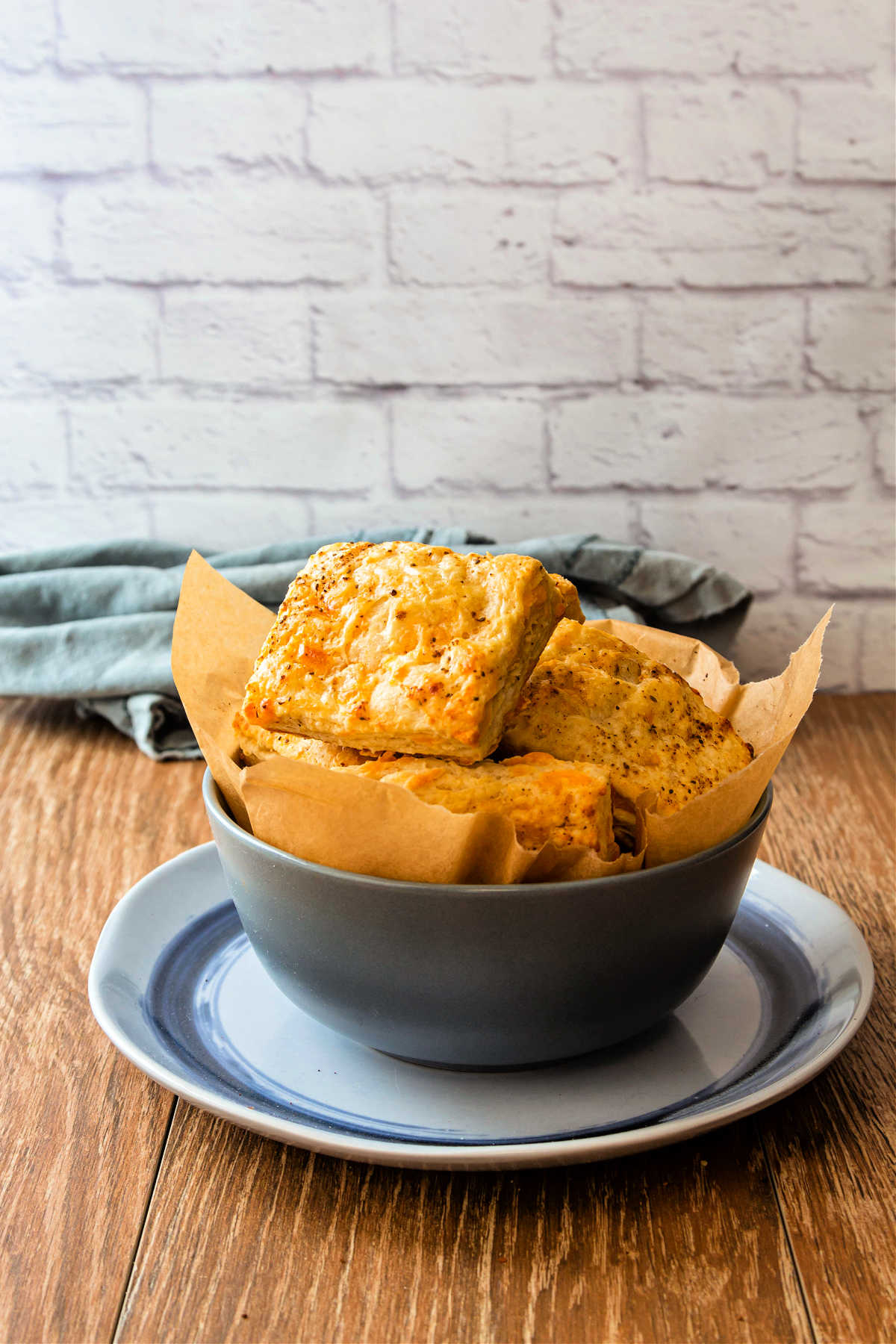
Testing The Recipe
This recipe is the third permutation of these biscuits, and I finally deem it perfect.
I made the first batch as “regular” biscuits, just mixing the cheese right into the dough and calling it a day. I also used more than my usual 1 teaspoon to 1 cup of flour ratio for leavening because many southern biscuit recipes call for as much as 1 1/2 teaspoons per cup.
Not to put too fine a point on it, these excess-leavening biscuits tasted of despair. I could taste the extra leavening as a soapy-chemical aftertaste that was no good for anyone.
For the second batch, I layered in the cheese rather than adding it with the dry ingredients.
They rose impressively, but they still had too much leavening (though the aftertaste wasn’t as pronounced. They were also decidedly too Old-Bayish without any other balancing flavors.
For Round Three, I:
- cut back the leavening to my usual ratio
- cut back on the Old Bay
- introduced some granulated garlic and onion.
How to Make Layered Cheese Biscuits
These biscuits are not difficult to make, but the technique is pretty important so you get nice layers and an impressive rise.
Here are the ingredients you’ll need.
Ingredients and Substitutions
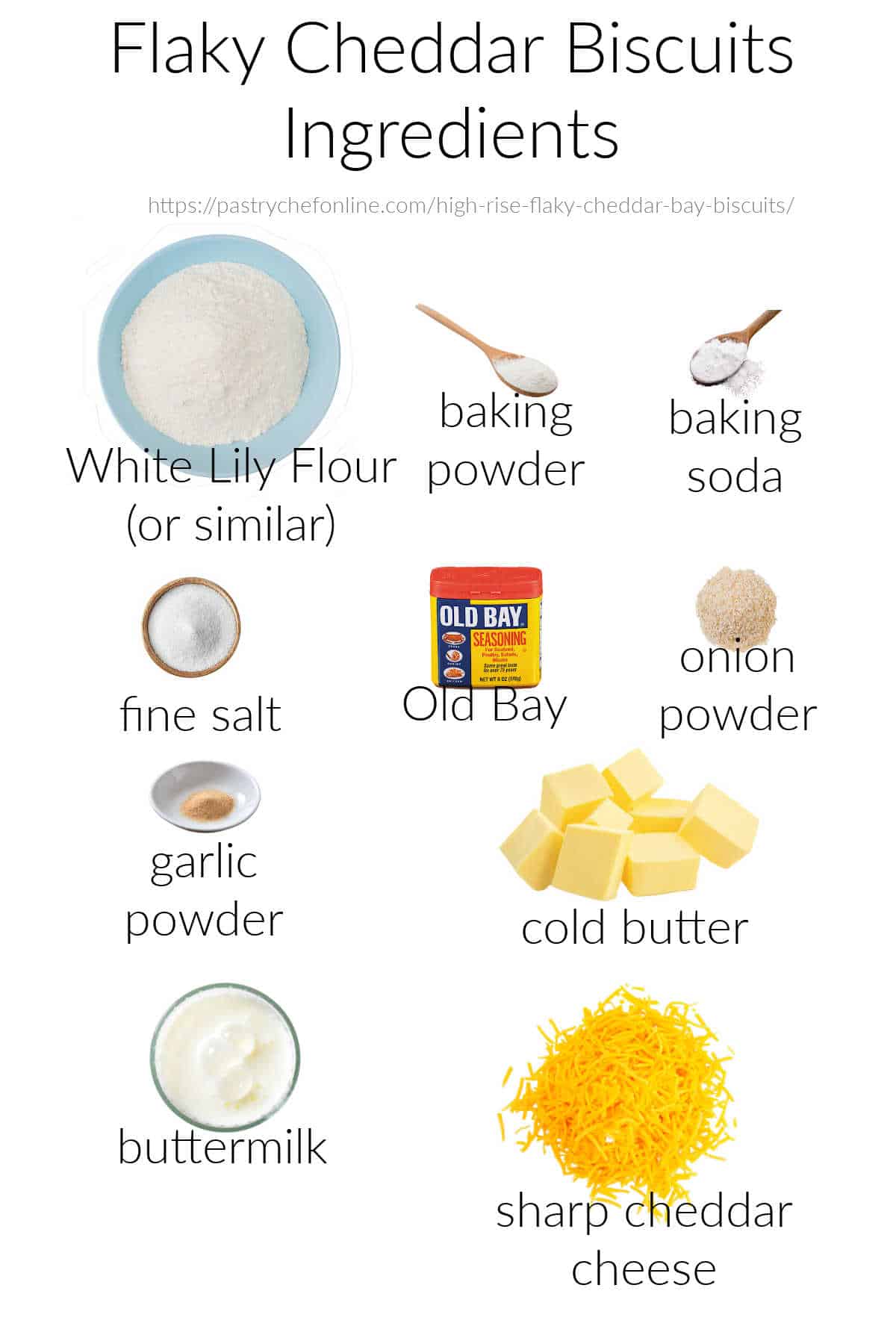
- flour: A low-protein all-purpose flour such as White Lily or Southern Biscuit is ideal. If you can’t find either brand, a “regular” all-purpose flour such as Gold Medal will work just fine. You can use King Arthur, but its higher protein content will make your biscuits just a little bit tougher
- baking powder: For leavening–most baking powder reacts (creating bubbles that allow the biscuits to rise) twice: once when it gets wet and another time when it gets hot. Hence the “double acting.”
- baking soda: Aids in leavening but is mostly in this recipe to balance the acidic buttermilk
- salt: For flavor. Please don’t leave it out, even if you use salted butter
- Old Bay Seasoning: A fantastic, all-purpose seasoning mix popular in and around Maryland. Celery salt, paprika, red and black pepper, plus who knows what else. The quintessential flavoring for Maryland crab cakes, the blend really makes these biscuits sing. Substitute celery salt or your favorite seasoning salt if you can’t find Old Bay.
- onion powder:
- garlic powder: You can use all onion powder or all garlic powder if you only have one. Just adds a hint of savory oniony goodness
- butter: I prefer unsalted, and you want it to be cold–straight from the fridge is just fine
- buttermilk: I use full-fat buttermilk, but the low-fat kind is fine too. If you don’t have buttermilk, substitute plain yogurt mixed with an equal amount of water or milk. I find this blend more closely approximates buttermilk than adding vinegar or lemon juice to milk does
- cheddar cheese: As far as I’m concerned, the sharper the better. I usually use New York sharp cheddar. Use your favorite
Procedure
First, I’ll go over the main steps to make these biscuits. Then I’ll break the “rolling and folding” down into component steps.
In a nutshell, here’s what you do:
- Whisk together all the dry ingredients.
- Rub in the butter with your fingertips.
- Pour in the buttermilk and mix until barely combined.
- Pat into a rectangle, then add the shredded cheese in a series of rolls and folds.
- Cut off edges to make a neat rectangle, and cut into squares.
- Brush with buttermilk and sprinkle with a little extra Old Bay.
- Bake.
Let’s break down making the dough just a bit.
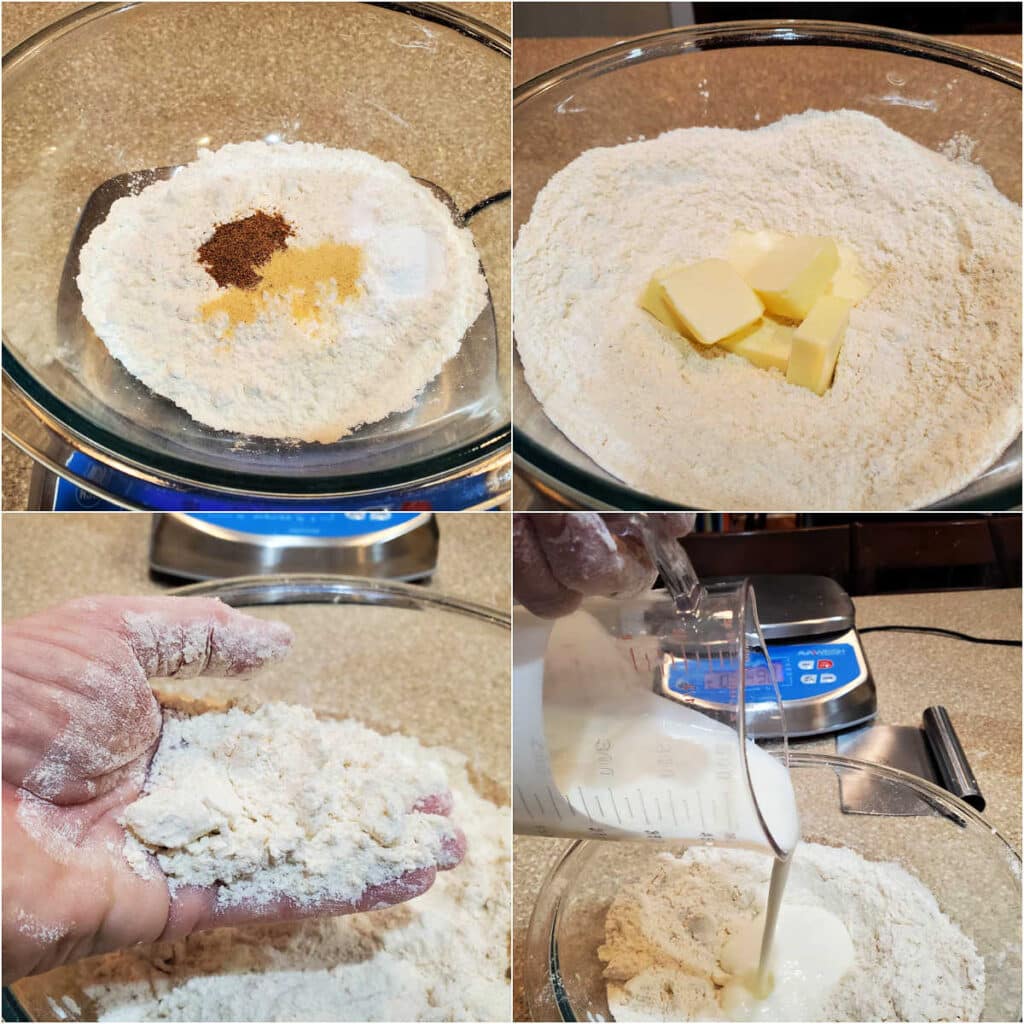
- Whisk all the leavening, salt, and spices into the flour.
- Drop in the butter and then rub it in with your fingers.
- The third photo shows the texture you are aiming for: some little pieces of butter and some larger pieces of butter. Don’t rub it in so well that the mixture looks “mealy.” You want fairly big chunks that will roll into flakes to help the layers puff up.
- Make a well in the center of the flour mixture, and pour in the cold buttermilk.
Pro Tip
Use a knife or the handle of a wooden spoon to stir the buttermilk into the flour mixture until you have a shaggy dough with some dry flour hanging out in the bottom of the bowl.
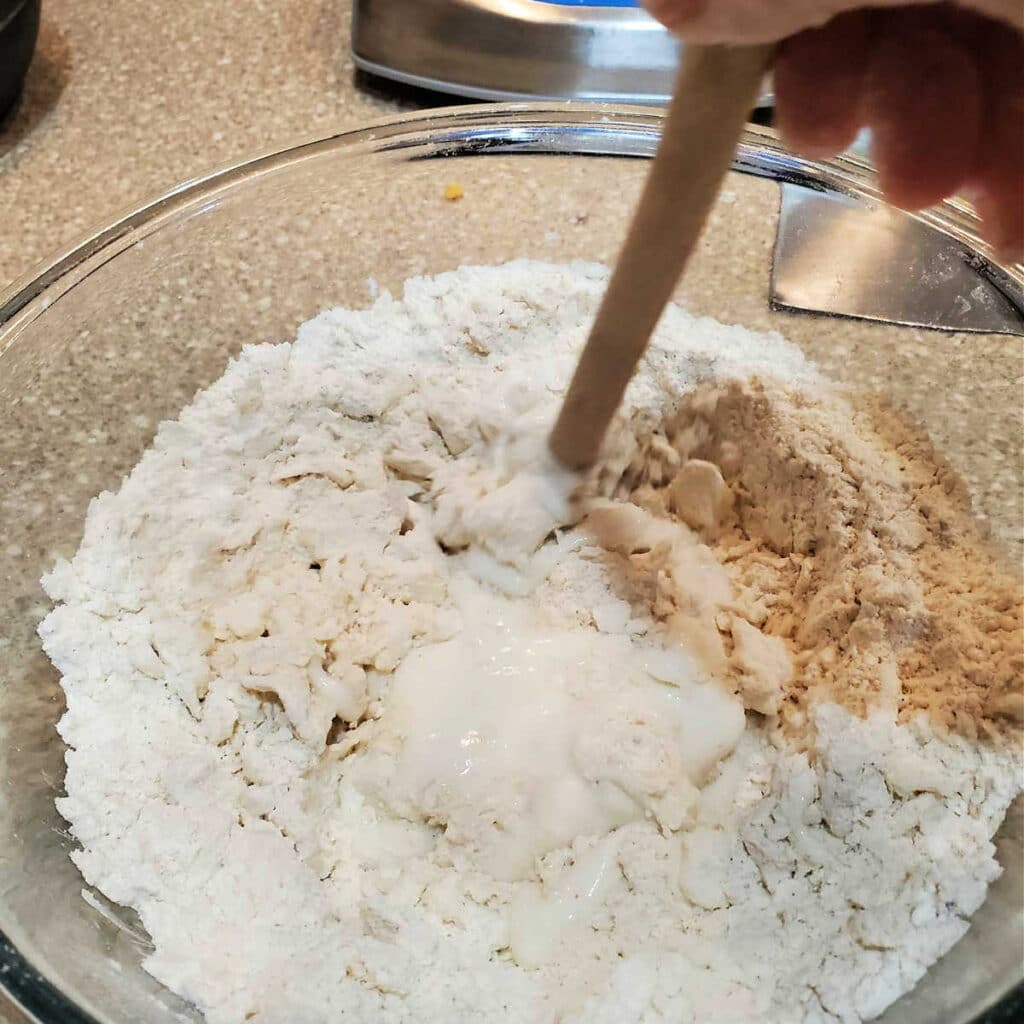
Once you’ve got your dough together, you need to get all that cheese in there, too.
Here’s how to make that happen.
Rolls and Folds
Flour your clean work surface and then:
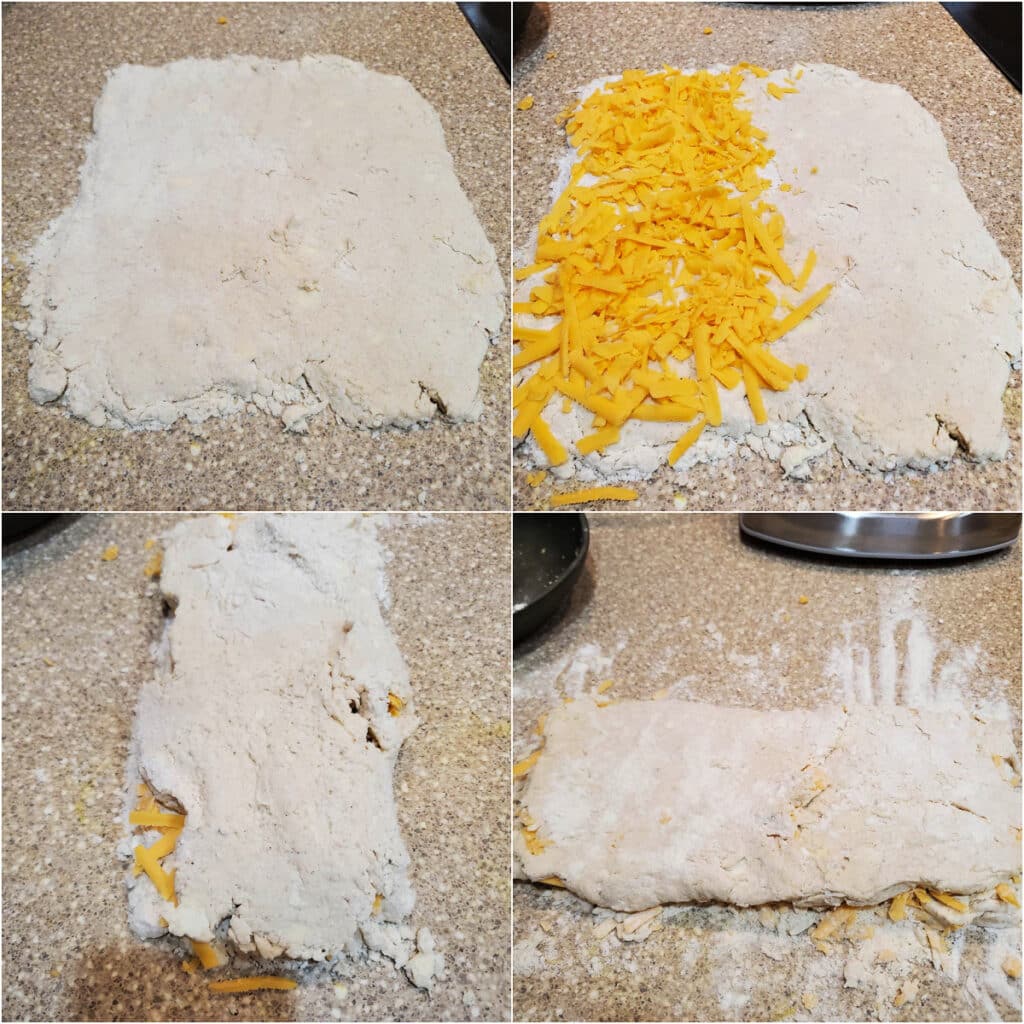
- Dump out the barely-mixed dough and sprinkle additional flour on top of it. Pat the dough into a rectangle.
- Add half the grated cheese to one side of the dough.
- Use your bench knife or a large spatula to help you flip the non-cheese side of the dough over on top of the cheese side.
- Rotate the dough 90 degrees.
Repeat those steps once more with the other half of the cheese.
Once the cheese is incorporated, you’ll switch to using a rolling pin.
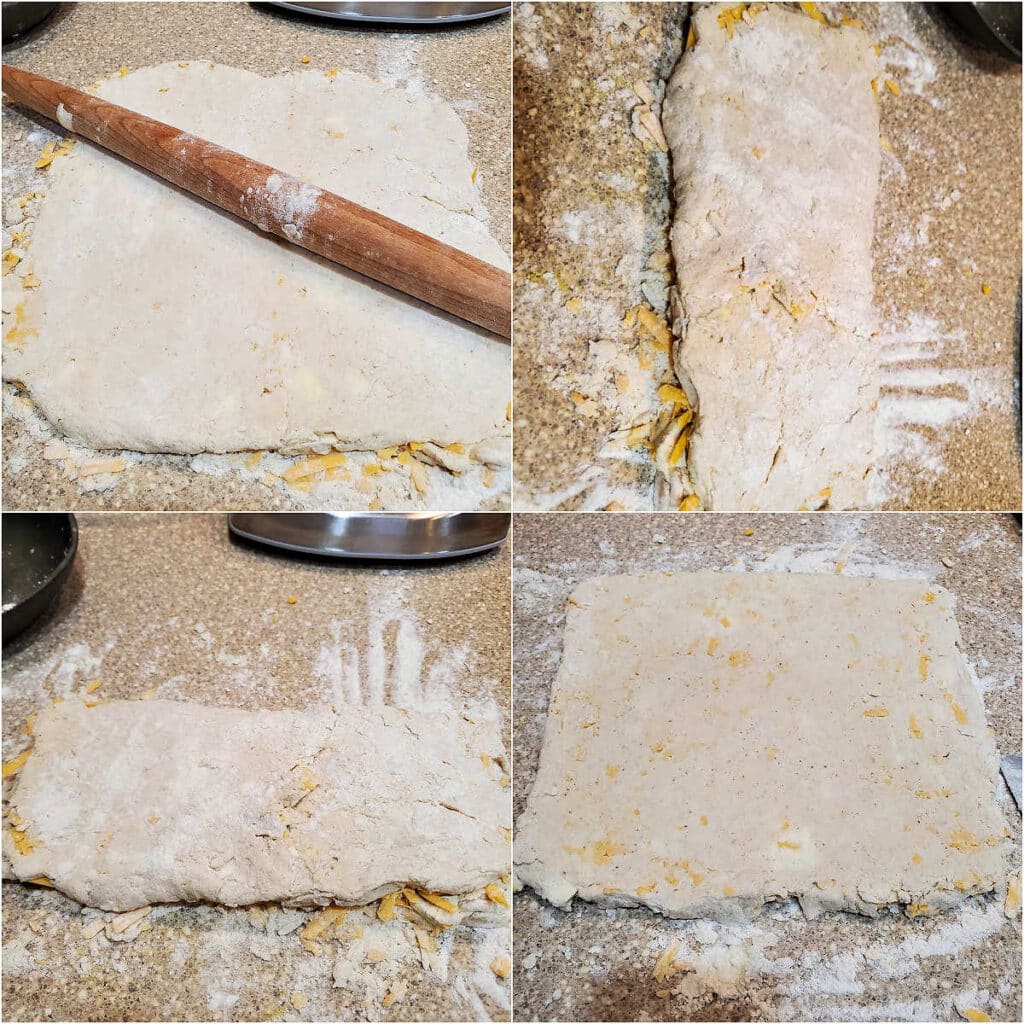
- Roll your dough into a rectangle that’s about 1/2″ thick.
- Using your bench knife to help you, fold it in half, scooping up any bits of cheese and/or dough that fall off.
- Turn the dough 90 degrees.
- Roll into a rectangle about 1/2″ thick.
You’ll repeat these four steps three more times for a total of six “turns:” two to incorporate the cheese and four more to build in extra layers.
Cutting the Biscuits
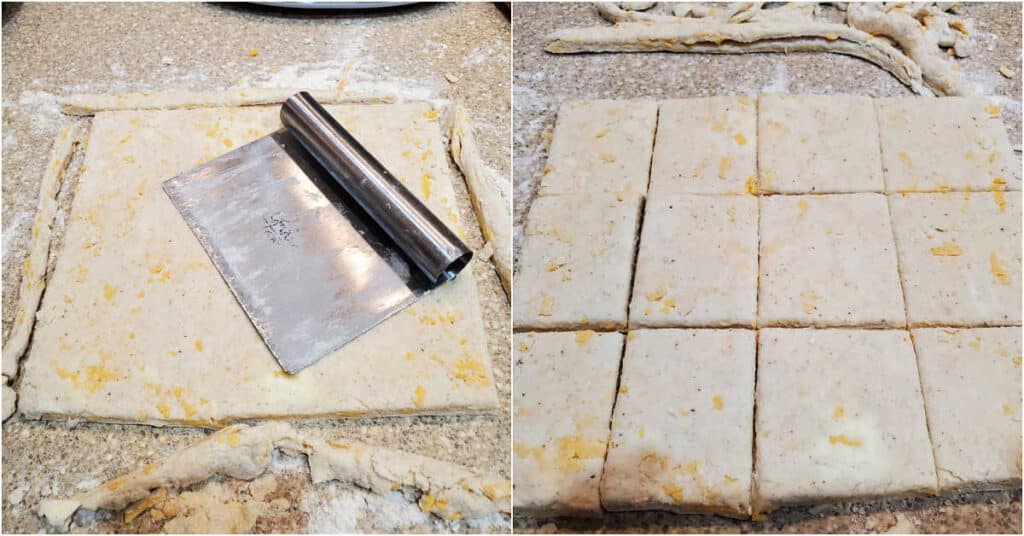
Once you have completed all your folds, Use your bench knife or a pizza cutter to trim off the edges of your dough on all four sides. Make sure you cut straight down.
Place your cut biscuits on a Silpat- or parchment-lined pan, brush the tops with buttermilk, and sprinkle lightly with some Old Bay or black pepper.
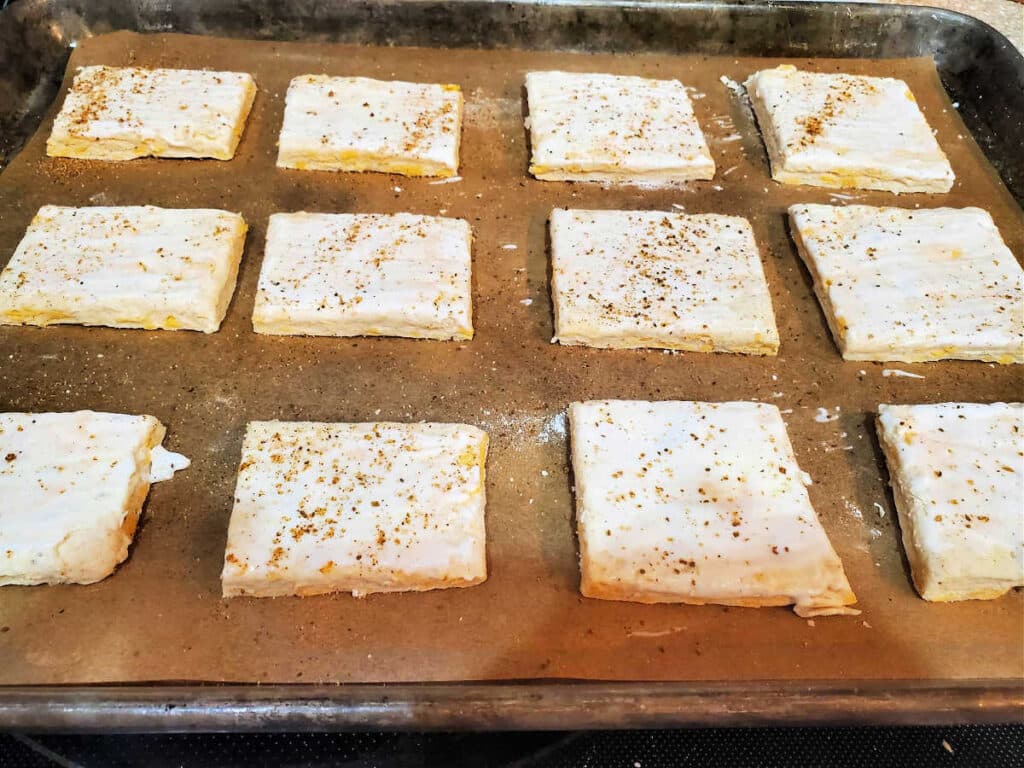
Equipment You May Need
The great thing about making cheese biscuits is that you don’t need a bunch of fancy equipment.
Grab a big bowl, your bench knife, a rolling pin, and a sheet pan and you’re good to go.
And of course, when it comes to accuracy, weighing is your best bet, so do get a kitchen scale.
You may also want to check out my list of tools for serious bakers.
Variations
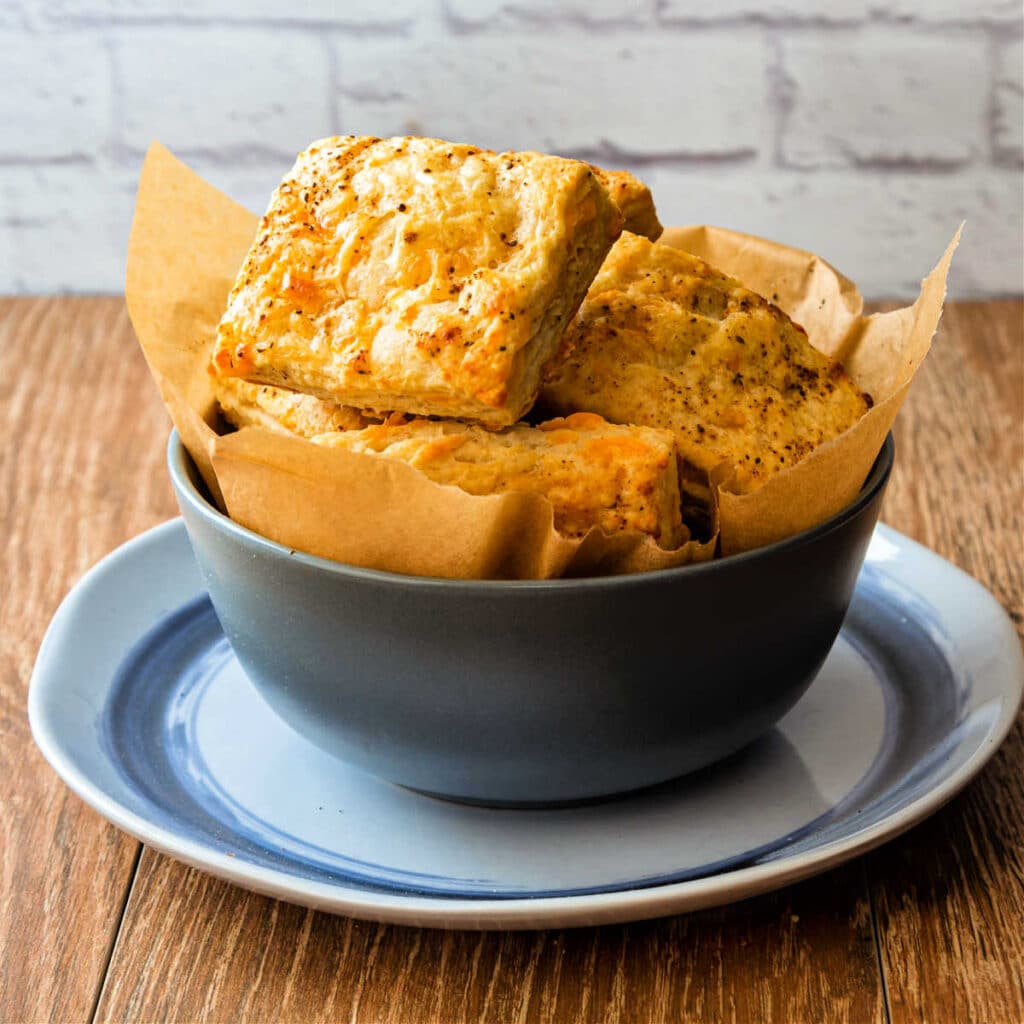
These cheese biscuits are endlessly adaptable.
Feel free to switch up your cheese choice with a different grating cheese such as Gruyere or provolone.
Vary the flavor of your biscuits by varying the spicing. Consider mustard powder, cayenne pepper, smoked paprika and more.
More Pro Tips
Smaller biscuits will rise higher than larger biscuits. For optimum rise, cut them into 1 1/2″ minis.
Freeze the cut biscuits for an hour or so before baking. This will ensure the butter and cheese are nice and firm. When they melt in the hot oven, the steam will lift help the layers apart.
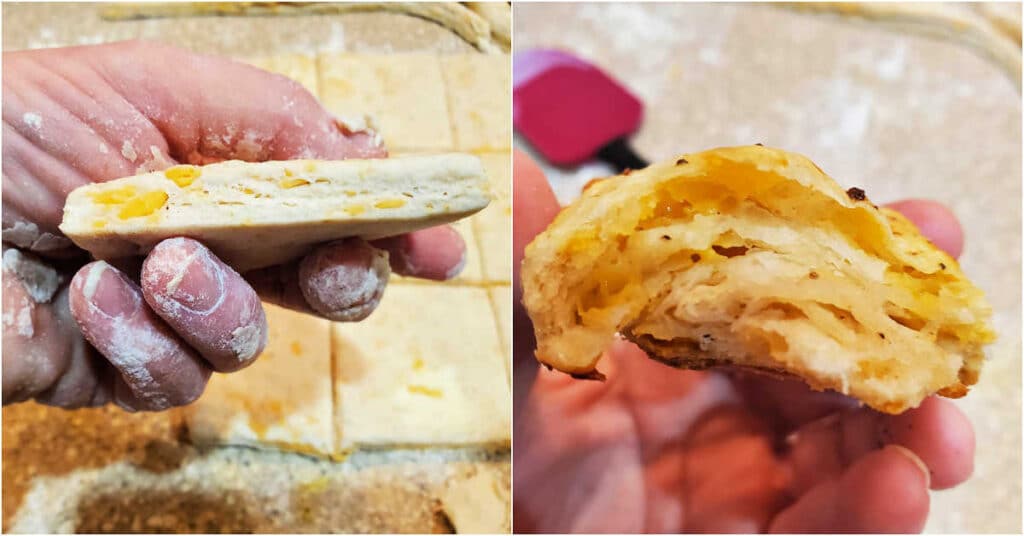
Flaky Biscuits Q & A
Biscuits are really best fresh from the oven. If you have leftovers, store at room temperature for up to a day and reheat in the oven for a few minutes at 350F.
Yes, you can freeze biscuits once they are completely cool, or you can freeze the cut biscuits before baking. Either way, place in a single layer in a zip-top freezer bag. Press out as much air as you can before sealing them. Thaw previously baked biscuits within a couple of months, refreshing them in the oven. Bake frozen biscuit dough from frozen. They will only take a minute or two longer than the recipe states.
Serving Suggestions
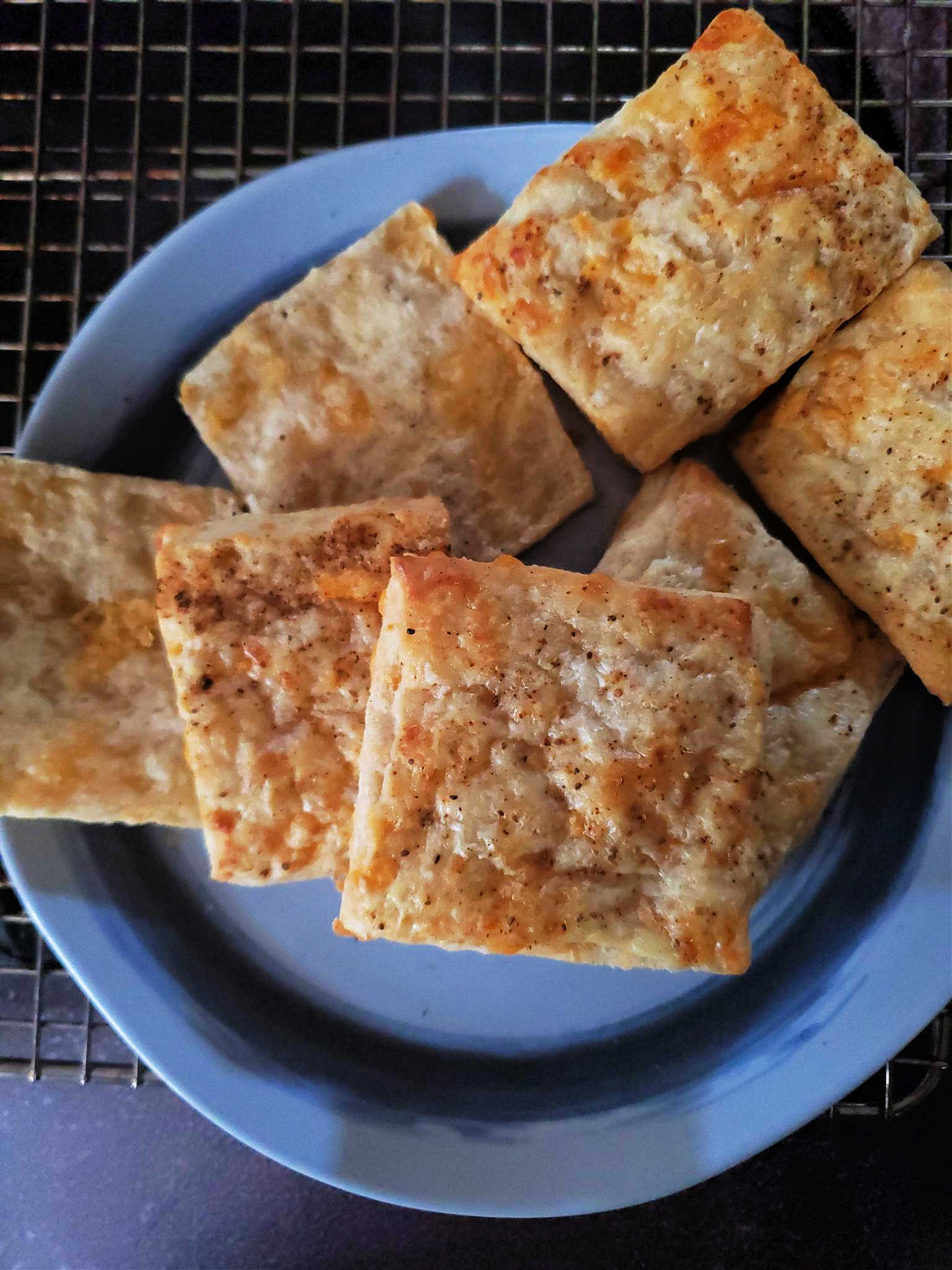
Cheddar biscuits are great when served with any kind of soup or chili.
Or just serve them as a bread option for dinner, regardless of what you’re serving.
Cut in about 3″ squares, they make great vehicles for breakfast sandwiches. Add a schmear of bacon jam or onion jam, and you’ll be happy you did!
If you’d like a non-cheese biscuit recipe, consider my all-butter angel biscuits. Those are tasty too!
A Note About Measurements
Don't let its small price and small size fool you. The Escali Primo is an accurate and easy-to-use food scale that I have used for years. It's easy to store, easy to use, has a tare function, and easily switches between grams and ounces/pounds for accurate measurements.
Questions
It will help me and other readers so much if you take a moment to rate and leave a review for this recipe.
You can use the stars to rate 1-5 (5 is best), and leave a review in the comments. It helps me make adjustments if any are needed, and comments help others decide whether the recipe is worth making.
Other ways to share include pinning, and/or sharing on your favorite social media platform.
Thank you so much for taking the time!

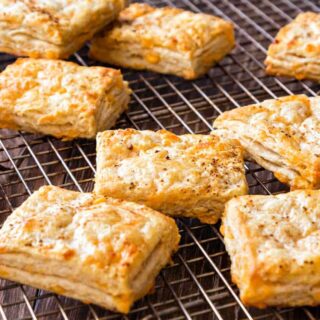
High-Rise Flaky Cheese Biscuits
Ingredients
- 9 oz low protein all-purpose flour such as White Lily or Southern Biscuit* (252 grams, or 2 cups measured by whisking flour, spooning lightly into a cup and leveling off with a straight edge)
- 2 teaspoons baking powder
- ¼ teaspoon baking soda
- ½ + 1/8 teaspoon fine sea salt
- 1 teaspoon Old Bay seasoning (plus a bit more for sprinkling on the tops)
- scant 1/4 teaspoon garlic powder
- scant 1/4 teaspoon onion powder
- 3 oz cold unsalted butter cut into 1/2″ cubes (84 grams, 3/4 stick or 6 Tablespoons)
- 7 oz cold buttermilk** (196 grams or scant 1 cup) plus a bit more for brushing the tops
- 4 oz sharp cheddar cheese 112 grams, grated and divided in half
Instructions
- Preheat your oven to 450F for about 30 minutes before baking. Place your oven rack on the second-to-the-bottom level and if you have a pizza stone, put it on that rack.
- In a large bowl, whisk together the flour, baking powder, salt, Old Bay, garlic powder and onion powder.
- Toss in the cold butter and rub it into the flour mixture with your fingertips until the largest pieces are the size of peas.
- Make a well in the center of your dry ingredients and pour in the buttermilk.
- Using a knife or a couple of fingers, stir the mixture until most of the flour is wet and you have a very shaggy dough. There will still be some loose flour in the bowl. Worry not.
- Liberally flour your work surface and dump out all the dough, piling the dry ingredients still left in the bowl on top of your shaggy dough.
- Lightly pat out the dough into a square or rectangle until it’s about 1/2″ thick. It should be about 11″x8″ or so. No need to be too precise. It still won’t look like much. Worry not.
- Take half the shredded cheese and spread it evenly on half of your rectangle of dough. It will seem like a very lot.
- Using your bench knife or a large spatula, fold the “naked” half of your dough over the cheese. You may have to piece it together, but carry on.
- Press and pat out the dough to the original size, turning it 1/4 turn.
- Add the second half of the grated cheese to half of your rectangle and fold over the dough again.
- Press the dough out to the original dimensions, trying to keep it as square as possible. Turn it 1/4 turn.
- Now that all the cheese is in there, you need to keep adding layers, so fold the dough again, pat it out to the original dimensions, turn 1/4 turn. Keep repeating this for a total of 6 turns, including the 2 where you added the cheese.
- Trim the edges of the dough with your bench knife or with a pizza cutter so you have an even rectangle.
- Square biscuits mean less waste, so cut the rectangle into however many biscuits you want. I made smallish ones and ended up with 16 biscuits, each about 2″ x 1 1/2″. Cut yours as large or as small as you want. You can cut circles, but biscuits cut out of the re-rolls will be much tougher.
- Place your biscuits on a parchment-or Silpat-lined baking sheet. Brush the tops with buttermilk and sprinkle lightly with a bit of Old Bay.
- Put your tray of biscuits onto the baking stone and bake for about 12 minutes (start checking at 10) until well risen and golden brown. If your oven bakes unevenly, rotate your pan after the first 7 minutes or so to promote even browning.
- Let cool just enough that you won’t burn your mouth and enjoy.
Did You Make Any Changes?
Notes
Storing
Store, tightly covered, at room temperature for a day. For longer storage, freeze in zip-top freezer bags, making sure to press out as much air as possible before sealing. They'll be fine for a month or two. Thaw before opening the bag. Reheat for 5 minutes at 350F. Don't microwave them or they'll be gummy.Baking from Frozen
Freeze the unbaked, cut biscuits for up to 3 months before baking. Place desired number of biscuits on a Silpat- or parchment-lined half-sheet pan. Brush the tops with buttermilk and sprinkle lightly with some Old Bay. Bake from frozen in a 450F preheated oven for 12-15 minutes or until deep golden brown on the bottoms and light golden-brown on the tops.Nutrition
Thank you for spending some time with me today. Enjoy the biscuits, and have a lovely day.

Hi, y’all! I hope you’ve enjoyed this post and hopefully also learned a thing or two.
If you like my style, I invite you to sign up for my occasional newsletter, The Inbox Pastry Chef.
Expect updates on new and tasty recipes as well as a bit of behind-the-scenes action. I hope to see you there!



Join in Today!

1
Hi Jenni, I’m not a big biscuit person but, these sound and look so good, then I’m going to try them! I wanted to ask you; what kind of little sandwiches do you make out of them? I think I want to try ham with some kind of tasty jam would be divine tasting!
I think ham and pepper jelly would be amazing. Or ham and egg. Making any kind of breakfast sandwich on them is definitely a good plan, too. Like with bacon and egg or maybe bacon jam or onion jam and all the breakfast-y goodies!
I’m so glad you’re going to give them a try, Em. The flavors are really great. Hope you love them!
Well, your ASSumptions are wrong. The architect of the recipe says there is no Old Bay in the recipe. They just named them Cheddar Bay to make them seem like they would go with seafood.
Be that as it may, Arty, they’re pretty delicious! I hope you have a lovely Thanksgiving.
YUM! I have only ever had biscuits like this in a restaurant – but to make them at home…? YES, please!
I think you will love them, Nichole! You get get more discrete layers by rolling with a rolling pin, but then you end up losing some of the tenderness. Either way, they’re delicious though!
I feel like your biscuit dough folding technique to get all that cheese in is probably really helpful at getting the nice layering we can see from the side view of the biscuits. I first read about the folding of biscuit dough in “Ratio” but I have yet to try it myself. Seems like a winning technique to me!
Also, I’ve never had a cheddar bay biscuit before! So many things to bake and eat, so little time (and so little stomach space for it all, sigh)!
I’m just going to go on record as saying that I was folding biscuits well before Ruhlman Ratio-ed it. LOL It really is a great technique and the only way to get actual layers. They rise really high too. You may not be able to get Old Bay in Canada, Janice (maybe on Amazon?) but it’s basically a seafood blend. Here’s a DIY version: http://leitesculinaria.com/81715/recipes-homemade-old-bay-seasoning-mix.html
These look absolutely incredible. Amazing shots too!
Thank you, Matt! I’m slowly learning how to use my new camera. Slowly being the key word! These guys are really delicious. Enjoy!